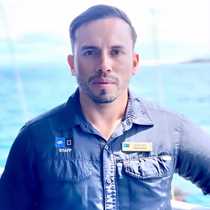Bartholomew & Santiago Islands
On this beautiful morning we woke up very early to visit the rusty but amazing looking island of Bartholomew. Having a dry landing, we soon headed up the wooden steps of the island, looking at the incredible geological features it had – like parasitic cones with their eroded craters and collapsed lava tubes. All of these features gave us the impression that we were walking on the moon.
When we got to the summit, we encountered the most astonishing landscape you could ever imagine. It gave us a view of the north and south beach of the island with the outstanding pinnacle rock. Amazed by the geology of the island we headed back to the National Geographic Endeavour for breakfast.
Still anchored in the same spot, we landed elsewhere on the beach and had a walk over sand dunes that led us to the south beach where we walked along the shoreline observing a big sea turtle nesting area. A couple of oystercatchers were also spotted. As we got back to the beach where we landed, some of us went snorkeling around Pinnacle Rock, swimming and also glass bottom boating.
After lunch we navigated to Santiago Island, disembarking on a volcanic sand beach at a place called Puerto Egas. Here some of us went on a hike along the coast of the island, while others preferred to explore the water world with snorkeling from the beach.
During the hike, the geology was very interesting, and we had a combination of pure volcanic rock and tuff, some parts giving us the image of chocolate chip cookie land, brown with black spots. As we got to the turn-around point of the hike, we walked over lava bridges made out of collapsed lava tubes where the sea water goes in and makes a perfect habitat for the Galápagos fur sea lion. As a matter of fact, here we saw a few sleeping on the rocks! Some shore birds like plovers, Ruddy turn stones and waders were also spotted as we walked along the coast.
We ended the day and the rest of our trip knowing that we still have places like this on the planet, but that it is in our hands to keep them well-conserved. After trips like this, we will for sure see the world with different eyes, with eyes of true conscience for nature having responsibility for this world on our shoulders.



